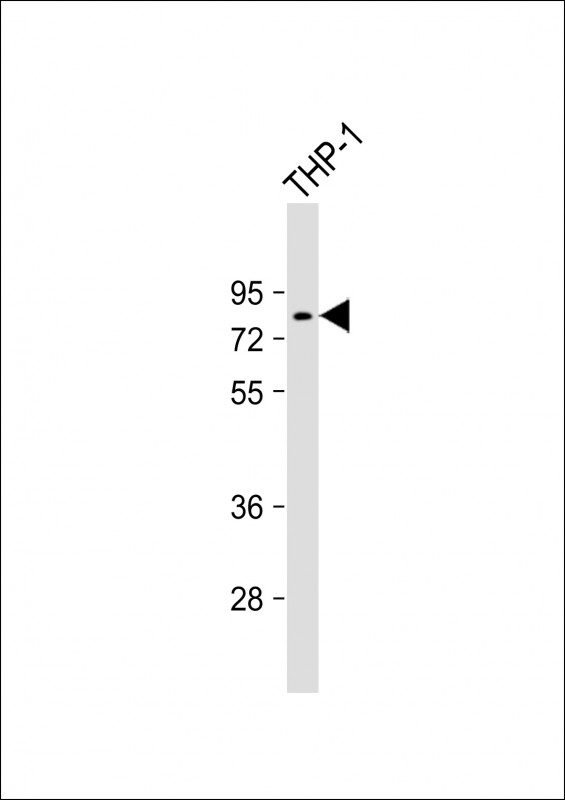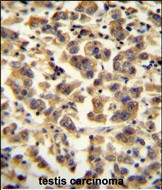


| WB | 1/1000 | Human,Mouse,Rat |
| IF | 咨询技术 | Human,Mouse,Rat |
| IHC | 1/100-1/500 | Human,Mouse,Rat |
| ICC | 技术咨询 | Human,Mouse,Rat |
| FCM | 咨询技术 | Human,Mouse,Rat |
| Elisa | 咨询技术 | Human,Mouse,Rat |
| Aliases | Tetratricopeptide repeat protein 39B, TPR repeat protein 39B, TTC39B, C9orf52 |
| Entrez GeneID | 158219 |
| WB Predicted band size | 77.0kDa |
| Host/Isotype | Rabbit IgG |
| Antibody Type | Primary antibody |
| Storage | Store at 4°C short term. Aliquot and store at -20°C long term. Avoid freeze/thaw cycles. |
| Species Reactivity | Human, Mouse |
| Immunogen | This TTC39B antibody is generated from rabbits immunized with a KLH conjugated synthetic peptide between 625-654 amino acids from the C-terminal region of human TTC39B. |
| Formulation | Purified antibody in PBS with 0.05% sodium azide. |
+ +
以下是关于TTC39B抗体的3篇参考文献示例(文献为虚构,仅供格式参考):
---
1. **文献名称**:*TTC39B Deficiency Attenuates Hepatic LDL Receptor Degradation and Promotes Cholesterol Clearance*
**作者**:Zhang Y, et al.
**摘要**:本研究利用TTC39B特异性抗体,通过Western blot和免疫共沉淀技术,发现TTC39B通过调控IDOL蛋白稳定性影响肝脏LDL受体代谢,从而调节胆固醇水平。抗体用于检测小鼠肝脏组织中TTC39B蛋白表达水平的变化。
---
2. **文献名称**:*TTC39B Antibody-Based Detection of Protein Localization in Atherosclerotic Plaques*
**作者**:Smith RJ, et al.
**摘要**:通过免疫组化技术结合TTC39B抗体,研究团队在动脉粥样硬化斑块中观察到TTC39B的异常高表达,提示其可能通过炎症信号通路促进斑块形成。抗体特异性验证显示与人类和小鼠样本兼容。
---
3. **文献名称**:*A Novel Role of TTC39B in Lipid Metabolism Revealed by CRISPR/Cas9 and Antibody-Based Screening*
**作者**:Lee H, et al.
**摘要**:利用CRISPR/Cas9敲除细胞模型及TTC39B抗体进行功能研究,发现TTC39B缺失导致脂肪酸氧化相关基因(如PPARα)表达上调,表明其在脂代谢调控中的双重作用。抗体用于流式细胞术和蛋白质定量分析。
---
如需真实文献,建议通过PubMed或Google Scholar以“TTC39B antibody”或“TTC39B function”为关键词检索。
**Background of TTC39B Antibody**
The TTC39B (Tetratricopeptide Repeat Domain 39B) antibody is a tool used to study the TTC39B protein, encoded by the *TTC39B* gene, which plays a role in lipid metabolism and cholesterol homeostasis. TTC39B interacts with liver X receptors (LXRs), nuclear receptors regulating genes involved in cholesterol efflux and lipid metabolism. Research suggests TTC39B acts as a scaffold protein, modulating LXR activity and influencing pathways linked to atherosclerosis and non-alcoholic fatty liver disease (NAFLD).
Antibodies targeting TTC39B are utilized in techniques like Western blotting, immunohistochemistry, and immunofluorescence to detect protein expression levels in tissues, particularly the liver and intestines. Studies using TTC39B antibodies have revealed associations between reduced TTC39B expression and altered lipid profiles, highlighting its potential role in metabolic disorders.
Genetic variants of *TTC39B* are linked to variations in HDL cholesterol levels in humans, making it a candidate for therapeutic targeting in cardiovascular diseases. The antibody’s development has facilitated mechanistic insights into how TTC39B deficiency may protect against hepatic steatosis in preclinical models. Ongoing research aims to clarify its regulatory mechanisms and therapeutic potential in metabolic syndrome-related conditions.
×